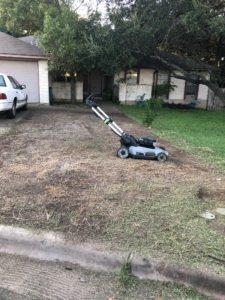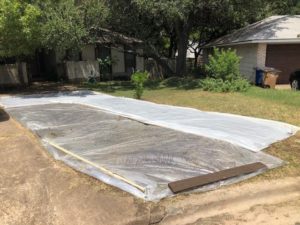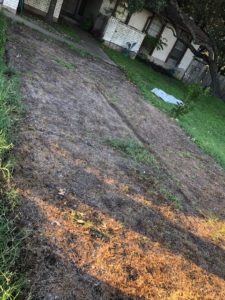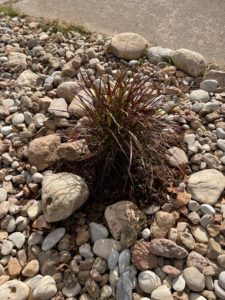Your August Gardening Project
Most people in the Austin area try to forget about the heat of summer, but there is one gardening project that is perfect for August. Research by horticulturists of the Texas A&M AgriLife Extension Service has found that soil solarization can suppress weeds both short and long term and is best done during the hottest days of the year.
A Drastic Solution?
Soil sterilization may sound like a drastic solution, but it’s actually an environmentally friendly way of using the sun to control soilborne weeds and pests. Using a transparent polyethylene cover to trap solar energy, the resulting temperatures and steam will kill bacteria, fungi, insects, nematodes, mites, weeds and weed seeds. Travis County Master Gardener Ann Roe solarized her front yard and shares why she chose this method, how she did it, whether she supplemented with herbicide, and the results that she’s achieved.
Choose the Right Site
There are two processes happening in soil solarization – heat and steam. Excess heat will kill most plants, even if they have bulbs or roots. However to kill nematodes, weed seeds, and insect eggs in the soil, you’ll also need hot steam.
Soil solarization works best on deeper, heavy clay soils, like those found on the east side of Austin. That’s because clay can hold more water than other soil types. Soil moisture is necessary to produce steam every day, which is a critical component to the sterilization process.
Solarization may be less effective on sandy or shallow soils like those found on the west side of Austin. These soils don’t retain water well, and therefore, will produce less steam. To maximize the benefit of solarization in sandy soils, lay drip irrigation lines under the clear plastic cover and add water regularly.
When Ann started her project, her goals were to add value to a rental property and help the environment. “I wanted to reduce mowing, add drought tolerant plants and provide native plants for pollinators.” To do this, she wanted to eliminate the yard full of weeds and start from scratch.
“The site gets a lot of sun. The 50% of the yard closest to the house gets more shade from the western sun but otherwise the yard faces East and gets sun all day.”
Choose the site carefully so that desirable trees and shrubs can be avoided. Planning ahead allows you to relocate plants you want to keep before summer arrives.
Six Steps to Soil Solarization
There are six recommended steps to solarize your soil.
Step One – Clear the area of plants and debris.

Ann first mowed the area as short as possible.
The first step is to clear plants and large debris like branches and all plants in the area you want to solarize. You can chop them off at ground level if you don’t want to disturb the soil.
Ann shares that “We mowed and raked and removed as much plant material as possible.” Raking also helps to remove large dirt clods or rocks. It’s important to have a smooth soil surface to prevent air pockets under the plastic covering.
Step Two – Water the soil deeply until it is wet.
July, August, and September are hot and dry in the Austin area and may have already baked out most moisture near the surface. Take time to water deeply until the soil is moist to a depth of six inches (just as if you were getting ready to plant in it.) Depending on how dry it’s been, it make take more than one irrigation session to accomplish this. Remember that steam is going to kill seeds, nematodes, and many pathogens, so it’s worth your time to ensure that the site has adequate soil moisture in reserve for the project. Use a trowel or shovel to check how deeply the water has penetrated.
If you have shallow or sandy soils, install drip irrigation so that you can add moisture when needed. Normally, water beads will appear on the underside of the plastic early each morning and disappear by noon after the water has turned to steam. When it looks like fewer beads are forming or don’t appear at all, turn on the irrigation and replenish soil moisture.
Step Three – Cover the area with clear plastic (such as 1 to 4 mil painter’s plastic).

Solarization area covered with plastic and held in place with boards.
Use clear, not white or black plastic; they don’t allow enough heat to get to the soil. Ann purchased her plastic from Amazon and Home Depot.
Step Four – Bury the plastic edges in the soil to trap the heat and steam.
Experts recommend that you bury the plastic edges so that you can trap the maximum amount of heat and steam. If you live on the west side and don’t have much soil, this may be a challenge.
Ann’s project was next to a driveway and sidewalk that made it difficult to dig, so she opted not to bury the edges. She used boards and tent stakes to keep the plastic in place. You can use other heavy objects like bricks or large rocks to keep the plastic from flying around.
Step Five – Leave the plastic in place for at least 4 weeks spanning the hottest part of the summer.
Austin area weather can be tricky mid-August through October due to the influence of hurricanes entering the Gulf of Mexico. You need to leave the plastic in place for at least four weeks of full sun. Adjust as needed depending on how many cloudy days may occur. Ann ended up keeping her plastic in place for a full six weeks.
Be careful not to walk on the plastic so that it doesn’t tear or move. You may have to install temporary fencing to keep pets off of it. Repair any damage and reseal seams as soon as you notice them.
Step Six – Remove the plastic and plant immediately.

After removing the plastic Ann discovered weeds at the edges and seams.
Unfortunately for Ann, part of the plastic seam opened and allowed weeds to grow. “I really wanted to avoid weed killer but it just wasn’t possible.” She has since found that she’s had to spot treat along the driveway and sidewalk.
Both Texas A&M and University of California recommend planting as soon as soil temperatures return to normal in a few hours after removing the plastic. Texas A&M recommends adding compost on top to restore soil microbes. Don’t till your soil because you don’t want to bring contaminated soil from below the solarization zone.
Ann added mulch when she added new plants, but says “I did not add compost. I was concerned about encouraging weed growth more than the new plantings. Time will tell if that is the right action.”
Ann landscaped her newly solarized area with Agave, Red Yucca, (Hesperaloe parviflora), Purple Fountain Grass (Pennisetum setaceum), Gulf Muhly (Muhlenbergia capillaris), Spineless Prickly Pear (Opuntia ellisiana), and Spanish Lavender (Lavandula stoechas.) Ann’s budget was $1,000 or less for the entire project. She added four yards of rock for $550. The plants and other materials cost approximately $150.

Purple Fountain Grass, (Pennisetum setaceum)
Worth the Time Spent
Ann says that it was worth the time spent. “I like how it looks. This was a test. I will do the rest of the yard next year.” The one thing she will do differently next time is purchase larger plastic sheets and leave them on for all of August and September.
Additional Resources
Soil Solarization; Masabni, Joseph G. and Franco, Jose G. Texas A&M Horticulture Department
Soil Solarization; Fennimore, Steve. Department of Plant Sciences, University of California
Soils and Composting for Austin
Low Maintenance Landscaping Tips
About Ann

Ann became a Travis County Master Gardener in 2015 after a 26 year career in Austin’s high tech industry. Her focus is native trees and ornamentals for central Texas. She believes the best part of the master gardener organization is the ongoing educational opportunities and finding like-minded Austinites to talk with about all things related to plants.

